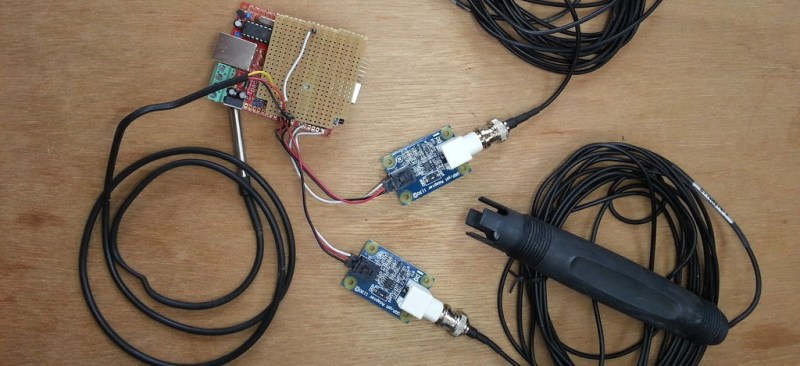Pools and hot tubs, although enjoyable, require monitoring and maintenance to keep the water clean and clear. [bhuebner] didn’t like having to constantly testing his hot tub’s vitals using test strips and water test kits. In an effort to autonomously monitor his hot tub’s water, he came up with a project he’s calling SpaSitter that records and tracks water quality indicators.
 The hardware is based on a Nanode (think Arduino with on-board Ethernet). Three sensors are connected to the Nanode and placed in his hot tub’s water. The sensors measure pH, ORP and Temperature. That data is then uploaded to xively.com where the data is not just stored, but tracked over time and displayed in graph-form. Checking the vitals on your phone can also get a bit tedious so [bhuebner] set up an email notification if one of the measured data streams go outside of a predetermined range. He still has to add chemicals manually and hopes to see some automation added to the next project revision.
The hardware is based on a Nanode (think Arduino with on-board Ethernet). Three sensors are connected to the Nanode and placed in his hot tub’s water. The sensors measure pH, ORP and Temperature. That data is then uploaded to xively.com where the data is not just stored, but tracked over time and displayed in graph-form. Checking the vitals on your phone can also get a bit tedious so [bhuebner] set up an email notification if one of the measured data streams go outside of a predetermined range. He still has to add chemicals manually and hopes to see some automation added to the next project revision.
[bhuebner] made his code available and also posted detailed instructions, including how to calibrate the sensors, for anyone wanting to do the same thing.
















Great project. I have been looking for more details on the probes but can’t find a detailed datasheet. Do the probes deteriorate over time being left in the pool? Do they need periodically re-calibrating?
Yes to both.
Any idea on what the schedule looks like? Someone in the phidget forms suggested once a month, but didn’t qualify that with anything…
Pools and hot tubs don’t need constant monitoring. Just get the alkalinity and pH correct at the beginning (and make sure your water has minimal dissolved iron). After that all I had to do was put half a cup of standard chlorine bleach in after each time in the hot tub. Occasionally if it looked a tiny bit cloudy when I took the top off I’d have to add extra chlorine.
But about every 3 months, hot tubs lose their balance and the water must be replaced.
My hot tub I simply strapped a DS18B20 flat side down to the inlet for the heater on the metal stuck the face with a bit of thermo glue and then wrapped it with a bit of foam insulation. I then read that sensor and stuck one in the water and recorded what the difference was (It was 1 degree) and simply skewed the readout by -1degF for display and logging.
A lot cheaper than the purpose built stuff. Remember you dont have to have the temperature sensor IN the water, you can read it from a pipe. Hot tubs always have a circulator pump running.
The only thing I ever learned from the data was that a new thicker cover was worth every penny, and that you need to stuff every cranny full of insulation you can around it.
I have been thinking about building something similar, i.e. I am halfway there from the other end. I have the heater, two speed pump controller running for my pool. I had not built the chlorine and PH testing bit, as last time I looked, the price of the sensors was beyond what I was willing to pay. I had not seen the sensors [bhuebner] is using. Will take a look. The only trouble I have with the 5 drop tests for PH is that I seem to be a bit colorblind on Red, so have to ask the wife or one of the daughters to cross check my color interpretation…. :)
https://eositis.wordpress.com/2014/05/27/pool-pump-controller-in-action/
Looks like purchasing a Nanode is difficult. Anyone know who might have a supply?
I think an Arduino and one of the WizNet or ENJ28C60 would do the same thing. I’m not sure how much of the sketch you’d need to change. I’m pretty sure I can do this with a Chipkit UNO32 and a W550io board.
I use the Arduino uno and a WizNet compatible shield for my projects now. Just wanted to see if the Nanode is a cost effective change. Given that it’s compatible with the Arduino shields…..ah well.
Could you share details about the sensors and where you got them?
Don’t know if this helps, but I have been thinking about the same sort of thing. Found this.
http://www.robotshop.com/en/analog-ph-meter-kit.html?gclid=COWXiKDx78UCFYWUfgodaH0AOA